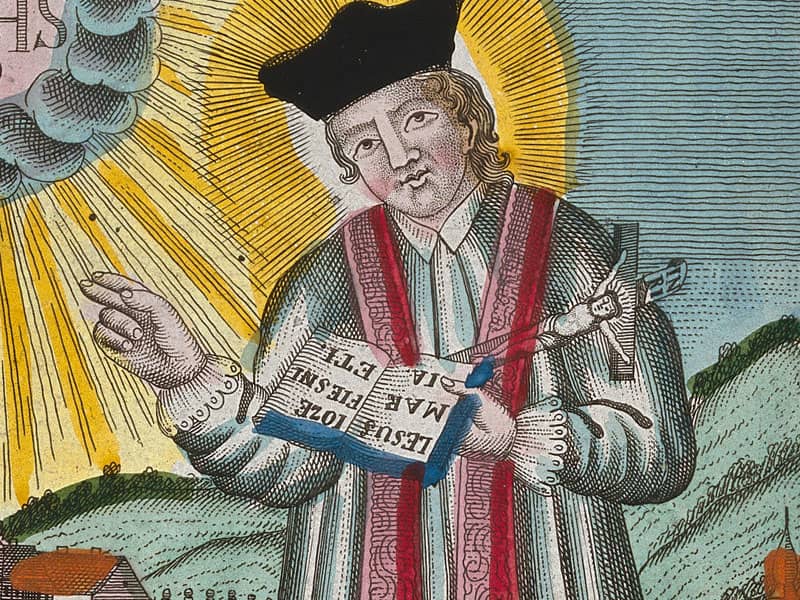February 14th is a day marked by exchanges of flowers, candies, intimate words, and—of course—love. You may already know that our contemporary Valentine’s Day stems from the legend of St. Valentine, but probably don’t know the whole story behind this holiday of lovers.
The story of Valentine’s Day is, like most holidays, a mixture of various faiths, traditions, and legends. There is evidence that, while the holiday’s name is derived from a Catholic saint, Valentine’s Day may actually find its origins in the pagan holiday of Lupercalia.
Celebrated on February 15th, Lupercalia was an ancient Roman fertility festival which had young men running naked in the streets, laughing as they drunkenly struck passersby with leather cords.
This celebration began with an animal sacrifice, conducted by men who marked their foreheads with the bloody knives they used to slay the animals. Afterward the blood was ceremonially wiped from the knives with wool dipped in milk. The ritual required that the men then laugh and smile.
After this, the Luperci would cut cords from the hides of the slain animals and run about, striking any woman they passed with the cords. A strike from the cord was thought to make a woman fertile, so women would gather in droves for this “blessing”.
Later in the day, a matchmaking lottery would be held, which involved slips of paper placed into a container. These papers had names of women written upon them, and men would draw these names, traditionally becoming sexual partners with the woman they drew for the rest of the year.
Those same ancient Romans executed two Christians, both of whom bore the name of Valentine, on February 14th in the 3rd century A.D. Their martyrdom laid the foundations for the repurposing of Lupercalia’s central themes.
In 494 CE, Pope Gelasius I outlawed Lupercalia, converting it into the Catholic celebration of St. Valentine’s feast day in honor of those slain Christians. At this point, it still resembled its pagan roots—the ritualism had been excised by the Catholic Church, but the idea behind the celebration remained the same—love and fertility.
The modern practices of Valentine’s Day bears the marks of the legend of Saint Valentine. According to this legend, Saint Valentine of Rome was imprisoned for performing wedding ceremonies for certain groups who were forbidden to marry, and for ministering to Christians, who were being persecuted by the Roman Empire at the time. According to legend, St. Valentine healed the daughter of the jailer and, before his execution, wrote her a letter signed, “Your Valentine”.
But the man we truly have to thank for Valentine’s Day as a romantic holiday is the famed writer, Geoffrey Chaucer, the 14th century author of “The Canterbury Tales”. It was he that established the link between St. Valentine and the idea of romance.
Chaucer wrote “Parlement of Foules” in 1382, which was penned to honor the first anniversary of the engagement of Kind Richard II. In this poem lies the bridge between the saint and the idea of love.
“For this was on seynt Volantynys day
Whan euery bryd comyth there to chese his make.”
These lines, which describes February 14th as the day birds come to choose their mates, likely hearkens back to the themes of Lupercalia, but branded with the name of the Catholic saint whose feast replaced the pagan holiday. Finally, all the dots connected, and Valentine’s Day was born, immensely popularized by Chaucer’s beloved work.
It wouldn’t be until the early 1700s that the traditions of Valentine’s Day would spread to America, when the exchanging of hand-made valentines caught hold. In 1847, Esther A. Howland began the first mass-production run of valentine cards. These weren’t the flat pieces of paper we know today—they were elaborate works of art, festooned with ribbons, pictures, and lace.
In the latter half of the 20th century, the exchange of simple cards and notes was expanded to include other familiar gifts, such as chocolate, roses, and jewelry, effectively commercializing the holiday. Today, Valentine’s Day remains an incredibly popular, with sales on Valentine’s Day reaching topping 19 billion dollars in 2016 alone, resulting in a holiday that some lament has become more about spending than loving.
But Valentine’s Day isn’t confined to the United States and Europe. Let’s take a look at a few traditions that exist outside of the West.
In China, the holiday is called the Qixi Festival, which is celebrated on the seventh day of the seventh month of the lunar calendar, and commemorates the day on which the Cowherd star and the Weaver Maid star are said to meet in passing.
In India, Valentine’s Day, as it is in the West, began to rise in popularity in 1992 due to the spread of commercial television, radio programs, and love letter competitions, but is harshly criticized by a large segment of the population due to its associations with colonialism.
Japan’s Valentine’s customs are quite unique—women traditionally give chocolates to men, although the romantic traditions traditionally associated with Valentine’s are reserved for Christmas Eve.
In Saudi Arabia, the religious police have banned the sale of all Valentine’s Day items, even going so far as confiscating red items from shops because the day is considered a Christian holiday. There is a black market for roses and wrapping paper, and more than 140 Muslims have been arrested for attempting to celebrate. But celebrate they do.
No matter what part of the world you’re from, no matter from what culture, class, or nation, you know what love is. You’ve experience it, been broken by it, been re-forged and renewed by it. And so it isn’t any wonder that Valentine’s Day, or a form of it, is celebrated all over the globe—love is universal.
So when February rolls around, don’t forget to show a little love to your sweetheart. You don’t have to buy expensive things or write Shakespearean sonnets. Love—the heart of Valentine’s Day—doesn’t need those things.
As the Beatles once sang, all you need is love.

